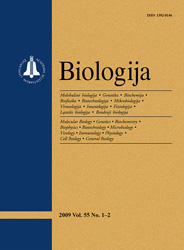 ISSN 1392-0146 ISSN 2029-0578 (online) |
2009 m. Nr. 3-4 The hydrolytic activity of Pseudomonas mendocina 3121-1 lipase. A kinetic study
The hydrolytic activity of Ps. mendocina 3121-1 (further marked as Ps. mendocina*) lipase was investigated using p-nitrophenyl butyrate (p-NPB) solutions in selected organic solvents (2-propanol, acetone, 1,4-dioxane and acetonitrile) as well as other soluble p-nitrophenyl fatty acid esters of different chain length in 2-propanol as substrates. In acetone, lower Km(app) and higher Vmax(app) were determined than in the other organic solvents used. The calculated Vmax(app) / Km(app) ratio was found to be higher in the latter case as well. The kcat(app) of p-NPB hydrolysis in 1,4-dioxane was shown to be nearly 4-fold higher than in other organic solvents, indicating the hydrophilicity of that solvent to be favourable for the hydrolysis. The kinetic parameters of hydrolysis of other fatty acid esters in the same organic solvent (2-propanol) were determined. This enzyme was shown to display highest activity when hydrolysing substrates of a moderate chain length (p-nitrophenyl laurate, p-NPL) at the same concentration of all esters (0.1 mM). Kinetic parameters were also determined for the hydrolysis of all fatty acid esters used, and the calculated parameters were compared with the determined ones. Km(app) was found to be higher for short fatty acid esters, and the lowest characteristics were determined for p-nitrophenyl caprylate (p-NPC), indicating Ps. mendocina* lipase to be more specific to soluble fatty acid esters of moderate and long chains. No strong dependence of lipase Km(app) on fatty acid chain length was determined, while the highest Vmax(app) was determined for p-NPL and p-nitrophenyl myristate (p-NPM), and the lowest one was shown to be for p-nitrophenyl acetate (p-NPA). The kcat(app) was found to be higher for p-NPC and p-NPL, showing the lipase specificity to fatty acid esters of a moderate chain. The Vmax(app) / Km(app) ratio was different for all substrates used, but for fatty acid esters of moderate and long chains it by far exceeded the ratio for p-NPA and p-NPB. The determined Vmax(app) was compared with the calculated parameter at the substrate concentration close to Km(app), and a significant correlation was found. Analysis of kinetic parameters at the substrate concentration close to Km and 5-fold lower than Km (at the same “kinetic profile”) showed the enzyme to be the most active upon p-NPL at “Km” profile, and the general dependence of activity on fatty acid chain length was found to be similar to the dependence when fatty acid esters had been used at the same concentration. In contrast, the hydrolytic activity was close for p-NPL and p-NPM and also was not so far from the activity for p-NPP and p-NPS at the substrate concentration in the “below Km” profile. A slight interfacial activation under formation of micellar structures using p-NPC as the substrate was determined. The kinetic constants of Ps. mendocina* lipase-catalyzed p-NPB hydrolysis in various alcohols were determined showing the inactivating effect of alcohols at various concentrations. When p-NPB solutions in each of the alcohols mentioned had been used as substrates, the hydrolytic reaction was detected only in most hydrophilic ones. The effect of micellar structure formation on Ps. mendocina* lipase-catalyzed Tween hydrolysis was investigated. It was found that the efficiency of the hydrolysis changed when the concentration of those detergents exceeded the critical micellar concentration (CMC). Keywords: Ps. mendocina lipase, fatty acids p-nitrophenyl esters, hydrolytic activity, organic solvents |
Issues:
2011 - Vol.57 No. 1, No. 2, No. 3 2010 - Vol.56 No. 1-4 2009 - Vol.55 No. 1-2, No. 3-4 2008 - Vol.54 No. 1, No. 2, No. 3, No. 4 2007 - Vol.53 No. 1, No. 2, No. 3, No. 4 2006 No. 1, No. 2, No. 3, No. 4 2005 No. 1, No. 2, No. 3, No. 4 2004 No. 1, No. 2, No. 3, No. 4 2003 No. 1, No. 2, No. 3, No. 4 2002 No. 1, No. 2, No. 3, No. 4 2001 No. 1, No. 2, No. 3, No. 4 |